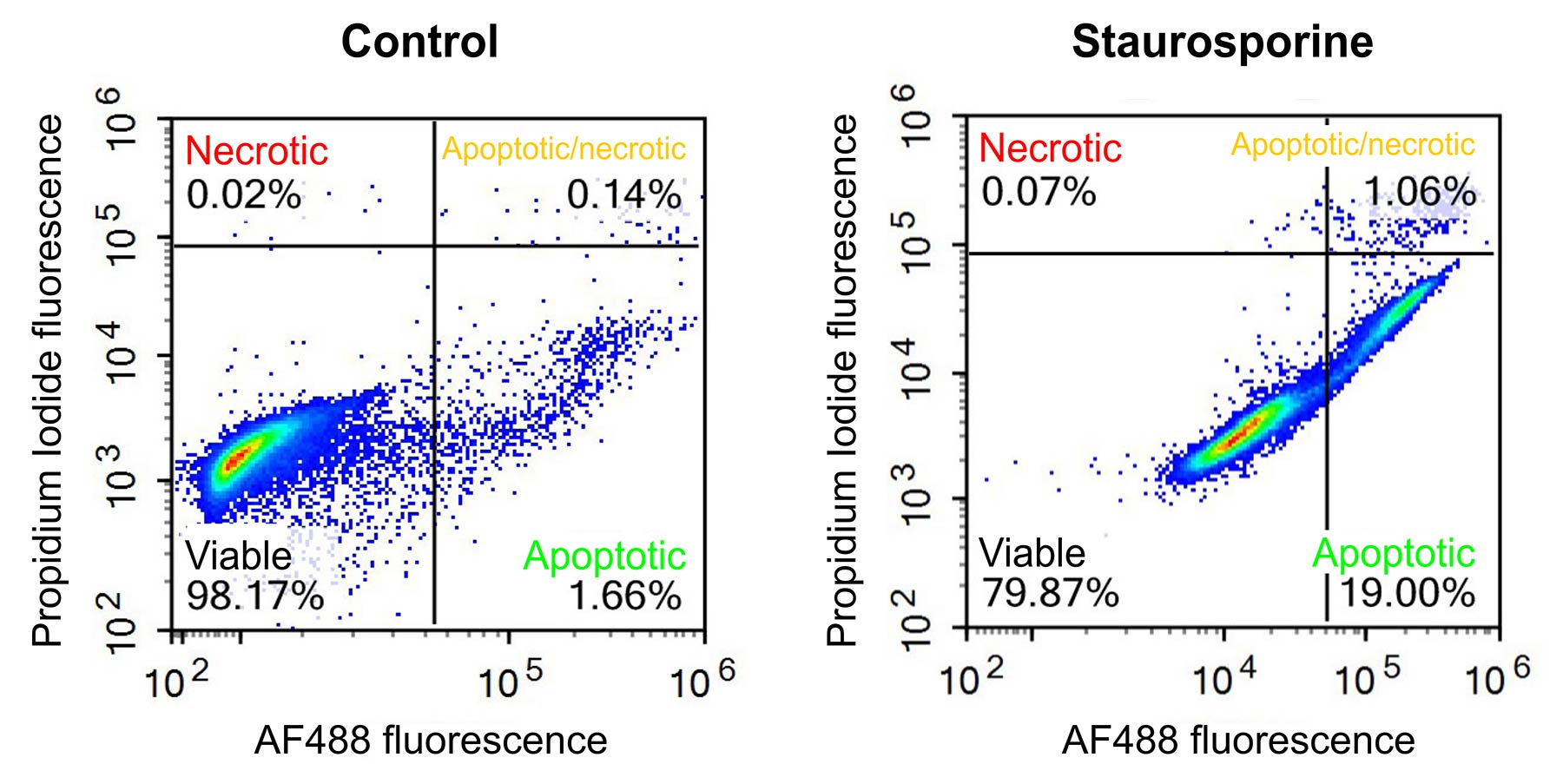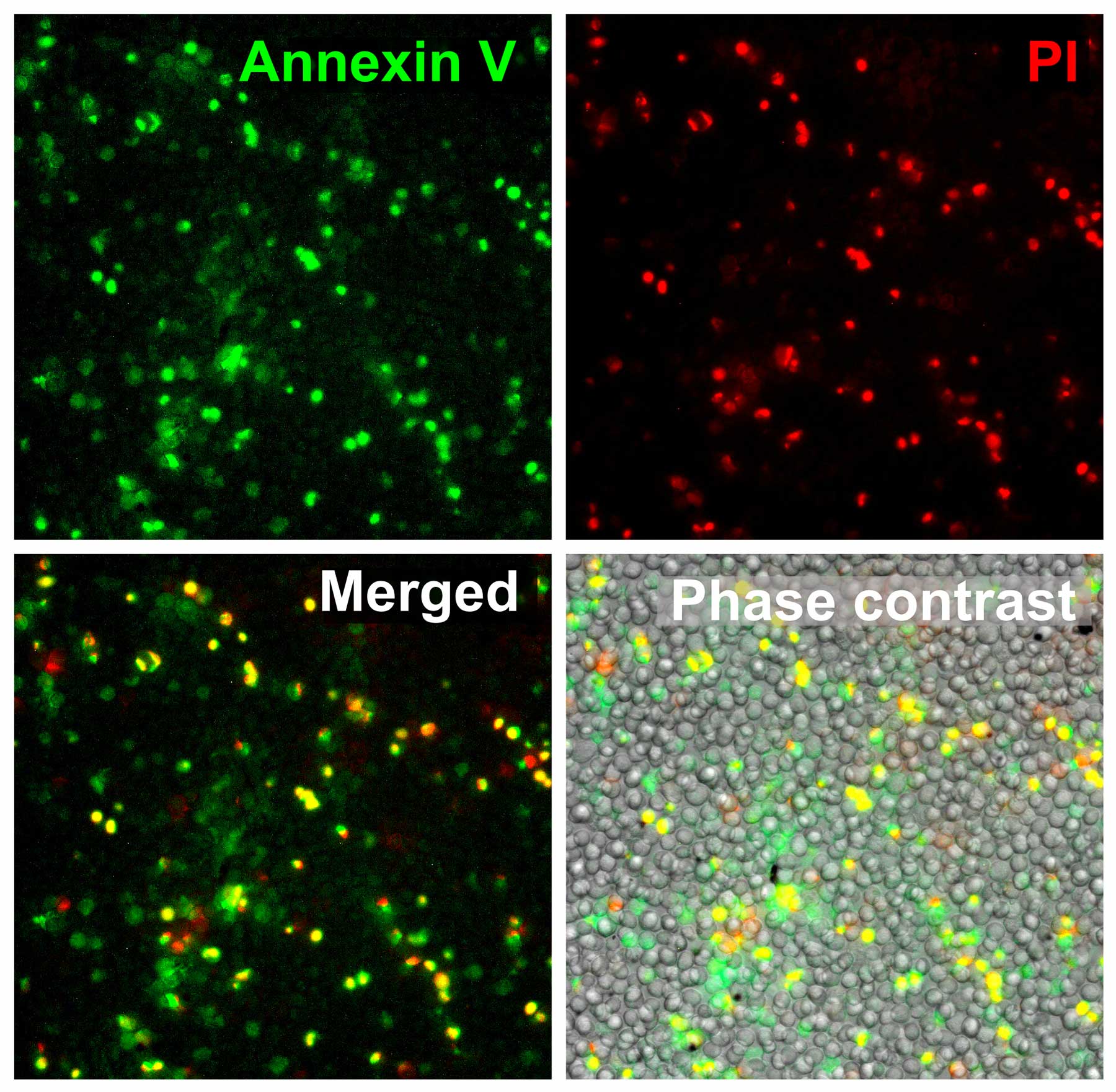Annexin V-AF 488 Apoptosis Detection Kit, with Propidium Iodide
| Cat. # | Quantity | Price | Lead time | Buy this product |
|---|---|---|---|---|
| 11172 |
10 assays
|
–
|
1 days | |
| 21172 |
50 assays
|
$215
|
1 days |

Annexin V (or Annexin A5) is a member of the phospholipid-binding annexin family of intracellular proteins. In flow cytometry and fluorescent microscopy, Annexin V is commonly used to detect apoptotic cells by its ability to specifically bind to phosphatidylserine (PS) in a calcium-dependent manner. The method was first reported by Koopman et al. (1994) [1].
In healthy cells, PS is normally retained in the inner leaflet of the plasma membrane. The early stage of apoptosis is accompanied by a loss of membrane phospholipid asymmetry, resulting in the exposure of PS at the cell's surface. In conjunction with vital dyes such as propidium iodide (PI), fluorochrome-labeled Annexin V can distinguish between healthy (Annexin−PI−), apoptotic (Annexin+PI−), and necrotic (Annexin+PI+) cells [2].

The ready-to-use kit contains all necessary reagents to label apoptotic cells with Annexin V-AF 488 conjugate and PI.
AF 488 is bright, photostable, and hydrophilic sulfonated rhodamine fluorophore. The dye emits in the green channel. The spectrum is similar with FITC. Its absorption max. is at 495 nm, the emission max. is at 519 nm.
PI is a membrane-impermeable DNA stain, making it useful for differentiating necrotic, apoptotic, and healthy cells based on membrane integrity. After DNA binding, the dye emits in the orange-red channel. Its absorption max. is at 535 nm, the emission max. is at 617 nm.
[1] Koopman G. et al. Annexin V for flow cytometric detection of phosphatidylserine expression on B cells undergoing apoptosis. Blood. 1994. 84(5). P.1415-1420.
[2] Martin S.J. et al. Early redistribution of plasma membrane phosphatidylserine is a general feature of apoptosis regardless of the initiating stimulus: inhibition by overexpression of Bcl-2 and Abl. J Exp Med. 1995. 182(5). P.1545-1556.
Product in action
Absorption and emission spectra of AF 488 and Propidium Iodide

Ready-to-use kit manual
Calculator
Customers also purchased with this product
Propidium Iodide
Propidium iodide is a membrane-impermeable intercalating DNA dye for staining nuclei of dead cells.Annexin V-AF 488 conjugate
Annexin V-AF 488 conjugate for detection of apoptotic cells by flow cytometry and fluorescence microscopy.General properties
| Storage conditions: | Transportation: at room temperature for 1 week. Store at -20 °С. |
| MSDS: | Download |
Kit
| Storage time in months: | 9 |
References
- Menchinskaya, E. S.; Chingizova, E. A.; Pislyagin, E. A.; Yurchenko, E. A.; Klimovich, A. A.; Zelepuga, E. A.; Aminin, D. L.; Avilov, S. A.; Silchenko, A. S. Mechanisms of Action of Sea Cucumber Triterpene Glycosides Cucumarioside A0-1 and Djakonovioside A Against Human Triple-Negative Breast Cancer. Marine Drugs, 2024, 22(10), 474. doi: 10.3390/md22100474














 $
$ 
